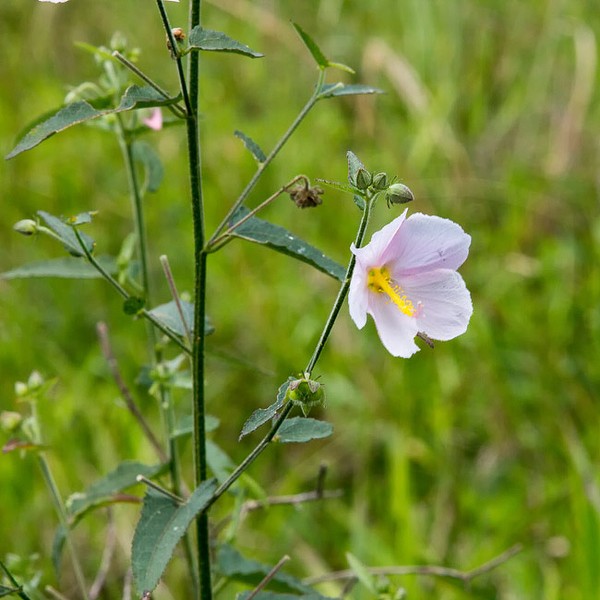Kosteletzkya pentacarpos (better known as K. virginica)
Malvaceae
Yesterday John and George hankered for scrub, so we wandered the dunes of Hobe Sound National Wildlife Refuge across the Intracoastal Waterway from the Isle of the Rich and Famous, none of whom read this blog. An extra bonus of HSNWR, even if tough to see, is a brackish coastal pond nestled among the desert dunes. Decorating the wet oasis is a pretty shrub fond of brackish wetlands, Virginia Swamp Mallow.
The shrub looks like a Hibiscus and is related, differing by having the woody capsule squashed flat, and splitting to release the seeds along the middles of the seed chambers as opposed to splitting at the edges. No doubt every reader will remember this gripping detail!
Spotting Virginia Swamp Mallow is a treat, standing tall with big eye-grabbing pink blossoms. The flowers exemplify textbook hummingbird-pollination, and the hummingbirds do hum there. But life never obeys the textbooks. Bee and butterfly visitation are reported too. More interestingly, the flowers have a self-pollination backup system. If the birds and bees disappoint, the stigmas (the five pollen-receptive knobs visible in the photo below) curl down to the pollen-producing anthers (the yellow organs below the stigmas) and take care of business independently. Floral closure at the end of the day helps with the selfies.

The blossom, by John Bradford. The stigmas are the five reddish lobes at the tip of the central column. These are surrounded by hundreds of yellow anthers along the column shaft.
Bioengineers like self-pollinated salt-tolerant species. The hungry world has expanding areas of under-utilized salinized (salty) soil, and brackish irrigation water is increasingly plentiful though obviously not applicable to many crops. Problem? Opportunity? One forgiving salt-tolerant crop is today’s Kosteletzkya; its seeds are miniature oil wells. Black gold! Texas tea! Lucrative opportunity!
A recent U.S. patent is dedicated to improving and farming Kosteletzkya and reaping diesel juice. As a side thought, there must be a fine line between freely farming a posie and squeezin’ its seeds, and enforcing a patent claim onto the little gushers! (Maybe someday we’ll have Roundup-Ready Swamp Mallows.)
One place where the squeezin’ occurs, at least at an experimental level, is coastal China with spreading tidal marshes where you can generate green fuel using crowd-pleasing flowers, stabilize the soil, and empower diesel-fueled migratory fowl.
Now for the daydreaming. That today’s pinkie oozes oil is no surprise, given a close relationship to cotton, as in cottonseed oil. And, speaking of China, they already grow much cotton there. Cottonseed oil is in the diet in parts of China, where it has caused temporary (I hope) male sterility. Or to the glass-is-half-full crowd, a potential male oral contraceptive. So on top of all the other wonders, could a Hobe Sound swamp bush loaded with unsaturated fatty acids have a future as Newman’s Own Reduced-Baby Salad Dressing? Call my patent attorney!
——————————-
——————————-
——————————–
A tree house, taken in Las Vegas last week in honor of our blog friend Uncle Tree, and his wonderful and popular poetic blog Uncle Tree’s House.


